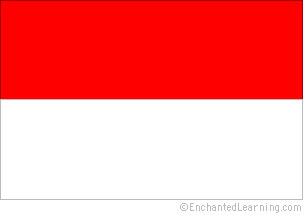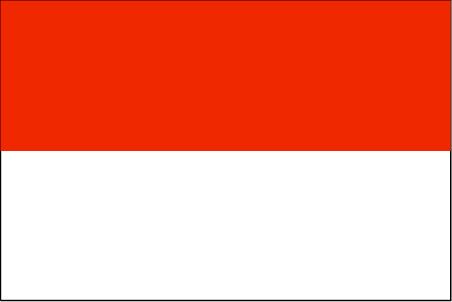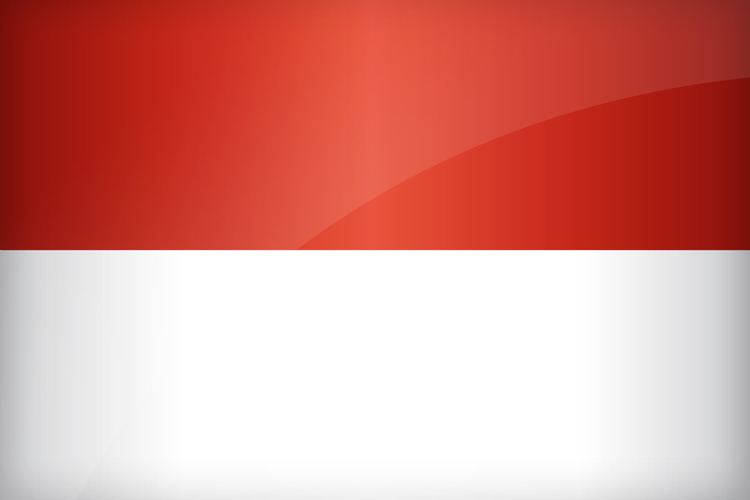Proportion 2:3 | Adopted on 17 August 1945 | |
Names Sang Saka Merah-Putih, Bendera Merah-Putih or Merah-Putih Design A horizontal bicolour of red and white Name Ular-Ular Perang (Naval Jack) | ||
The Flag of Indonesia is a simple bicolour with two equal horizontal bands, red (top) and white (bottom) with an overall ratio of 2:3. It was introduced and hoisted in public at the Indonesian Independence declaration ceremony on 17 August 1945 in Pegangsaan Timur street and Independence from the Netherlands on 17 August 1950. The design of the flag has remained the same since.
Contents
- History
- Alternative origin
- Name
- Symbolism
- Regulation and flag protocol
- Half mast
- Prohibited acts
- Flag anthem
- Similar flags
- References
The Naval Jack of Indonesia is reserved for sole use by the Indonesian Navy. It flies from every active Indonesian war ship mast. The design of the jack is described as nine alternating stripes of red and white. It is nicknamed Ular-ular Perang (War Pennant or literally "War Snakes"), probably due to the stripes' design. The naval jack dates to the age of Majapahit Empire. The Majapahit Empire, renowned for its great maritime strength, flew similar jacks on its vessels.

History

The flag's colours are derived from the banner of the 13th century Majapahit Empire. However it has been suggested that the red and white symbolism can trace its origin to the older common Austronesian mythology of the duality of Mother Earth (red) and Father Sky (white). This is why these colours appear in so many flags throughout Austronesia, from Tahiti to Madagascar. The earliest records of the red and white panji or pataka (a long flag along a curved bamboo pole) can be found in the Pararaton chronicle; according to this source, the Jayakatwang troops from Gelang-Gelang hoisted the red and white banner during their invasion of Singhasari in the early 12th century. This suggests that even before the Majapahit era, the red and white colours were already revered and used as the kingdom's banner in the Kediri era (1042-c.1222).

Red and white textile colouring was available in ancient Indonesia. White is the natural colour of woven cotton fabrics, while red is one of the earliest natural dyes, acquired either from teak leaves, the flowers of Averrhoa bilimbi, or the skin of mangosteen fruits.

It was not only the Javanese kingdoms that used red and white. The battle flag of King Sisingamangaraja IX of Batak lands bore an image of white twin swords called piso gaja dompak against a red background. During the Aceh War of 1873-1904, Aceh warriors used a battle flag with the image of a sword, star and crescent, sun, and some Quranic script in white on a red background. The red and white flag of of the Buginese Bone kingdom in South Sulawesi is called Woromporang. The Balinese Badung (Puri Pamecutan) royal banner is red, white, and black, probably of Majapahit origin. During the Java War (1825–1830) Prince Diponegoro also used a red and white banner.

In the early 20th century these colours were revived by students and then nationalists, as an expression of nationalism against the Dutch. The modern red and white flag which was first flown in Java in 1928, was prohibited under Dutch rule. Upon Indonesia's declaration of independence on 17 August 1945 it was adopted as the national flag, and has been in use ever since.
Alternative origin
There is another story about the flag of Indonesia, which is significantly related to the flag of the Netherlands. Under the colonial rule of the Dutch, the Netherlands (red-white-blue) flag was flown over Indonesia, while the flag of Indonesia (red-white), which was already created by 1930, was prohibited from being flown. A famous event, the "Hotel Yamato incident", happened on 19 September 1945, on the roof-top of Hotel Majapahit in downtown Surabaya, where young Indonesian revolutionaries tore away the blue part of the Dutch flag flown over the hotel to change it to the Indonesian flag in the lead-up to the Battle of Surabaya. The blue element in the Dutch flag was understood as representing the "blue-blooded" aristocracy of the Kingdom of the Netherlands. Conversely, the flag's red element represented the blood shed by anti-colonial nationalists in the War of Independence, while the white element could be understood to symbolise the purity of the Indonesian people.
Name
The official name of the flag is Sang Merah-Putih (The Red-and-White) according to Article 35 of the 1945 Constitution. The flag is commonly called Bendera Merah-Putih (Red-and-White Flag). Occasionally, it is also called Sang Dwiwarna (The bicolor). Sang Saka Merah-Putih (The Lofty Red-and-White) refers to the historical flag called Bendera Pusaka (heirloom flag) and its replica. The Bendera Pusaka is the flag that was flown in front of Soekarno's house a few moments after he proclaimed Indonesia's independence on 17 August 1945. The original Bendera Pusaka was sewn by Mrs. Fatmawati Soekarno, and was hoisted every year in front of the presidential palace during the independence day ceremony. It was hoisted for the last time on 17 August 1968. Since then it has been preserved and replaced by a replica since the original flag was deemed to be too fragile.
Symbolism
Several opinions have been expressed on the meaning of the red and white in the Indonesian flag. One opinion is that the red stands for courage, while the white stands for purity. Another is that red represents the human body or physical life, while white represents the soul or spiritual life; together they stand for a complete human being.
As Sukarno said:
Red is the symbol of courage, White is the symbol of purity. Our flag has been there since 600 years ago.
Traditionally, most Indonesians have used red and white as their ceremonial colours, mixing the colour of sugar (the red colour comes from palm sugar or gula aren) and rice (white in colour). Inarguably, until today, both of these are the major components of daily Indonesian cuisine or cooking. The Majapahit Empire have the same colours in its flag.
Regulation and flag protocol
The flag is described in Article 35, Chapter XV, of the Constitution of Indonesia; Government Regulation No. 24/2009; and Government Regulation No.40/1958.
The national flag shall be Sang Merah-Putih (The Red-and-White)
The raising of the flag should be conducted in the time between sunrise until sunset, but in certain circumstances, it can be done at night. In daily use, the flag should be flown at every commemoration such as Indonesian Independence Day on 17 August every year, by the citizens who has a right to use it at house, building or office, educational units, public transport and private transport and the representative office of Indonesia in overseas.
It can be used as the cover of the coffin of President or former Presidents, Vice President or former Vice Presidents, Members of Cabinet, Speaker of People's Representative Council, and Head of Government, members of the Indonesian Armed Forces, and person who is the members of Indonesian National Police who died in service, or an Indonesian citizen who contributed to their nation as a badge of honor.
The flag must be displayed everyday in places such as Presidential Palace, all of government and private office buildings, border posts and outer islands in the territory of Indonesia, and National Heroes Cemetery.
The flag should displayed everywhere on special days as follow:
Half-mast
The flag should displayed at half-mast as a sign of mourning on these days:
Usually, Indonesian flag also flown at half-mast on 30 September, in remembrance of the 30 September Movement, but after the New Order ended in 1998, this tradition stopped. However, in recent days, it still continues in some staff without official status by the government.
Prohibited acts
Based on Government Regulation No.24/ 2009, all citizens are prohibited from:
Letting the flag fall to the ground is also strictly prohibited, although it's not regulated by law. Most Indonesians consider it a humiliation to the flag, nationalism, and also heroes who have been fighting for independence from colonialism.
Flag anthem
The song was created by Ibu Sud with title Berkibarlah Benderaku (Flutter-on, O My Flag). She made it after seeing the persistence of Jusuf Ronodipuro, the head of RRI (Radio Republik Indonesia), ahead of the Operation Product in 1947, in which he refused to lowering the Red-and-White in the office of RRI, although he was threatened with firearms by Dutch troops.
Similar flags
The flag is similar to the flag of Poland, which is white (top) and red (bottom), and the flag of Singapore, which has a half crescent and 5 stars in the top red band. The flag is identical to the historical flag of Alsace (former region of France), the flag of Hesse (a German state) and the flag of Monaco, excluding the ratio.
